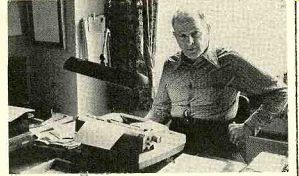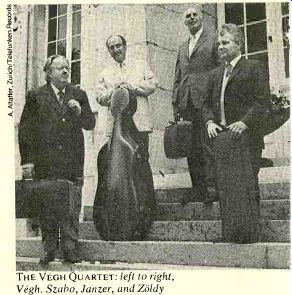
by IRVING KOLODIN
LATE, LATER, LAST BEETHOVEN
IN a time when it has become simple semantic habit to think of world political influence in terms of "powers" and "superpowers" it may not be entirely unreasonable to speak, when the subject is chamber-music proficiency, of quartets and super-quartets.
Almost all the string quartets that have attained sufficient reputation to record at all can compete with each other in the standard repertoire of Mozart and Haydn, of Schubert and Dvorak, plus much of Beethoven, Brahms, and others. Superiority on these lower slopes of the literature rests largely on temperamental affinity, stylistic awareness, and interpretive finesse, in addition to the kind of plain hard work that (all other considerations aside) has given, say, the Tokyo Quartet dominance in Mozart, the Melos Quartet leader ship in Schubert.
There are, of course, some works among those mentioned above that can separate ma ture musical men from the still-aspiring boys.
But there are also a particular few in the whole of the literature whose requirements put total fulfillment beyond the reach of all but the super-quartets, Beethoven's Opp. 127, 130, 131, 132, and 135 being perhaps the best examples. The latest to run this five-part gauntlet in recordings and expose their credentials in all their nakedness are the Smetana Quartet of Prague (Supraphon 111 1151/4) and the Vegh Quartet (Telefunken 251113-T/1-4), whose origins are Hungarian.
The five works are usually referred tows the "late" quartets. The term is defensible, but still a little generalized. As the period of com position extended from 1824 almost to the month of Beethoven's death in 1827, so the breadth of compositional content, intellectual energy, and spiritual substance they embody defies any adequately inclusive terminology.
For myself, I think of them not collectively as "late," but individually as late (E-flat), later (A Minor, B-flat, and C-sharp Minor), and last (F Major). In my view, Op. 127 in E-flat has more affinity with the works that preceded it (especially those of Opus 59) than with those that followed, and Op. 135 has only a dangling connection with what Beethoven might have written thereafter but never did.
In their own determined way, Jifi Novak, Lubomir Koateckj,, Milan Skampa, and An tonin Kohout, the foursome who together bear the name of Czechoslovakia's greatest composer, share not only a high sense of pur pose but an abiding love for these Beethoven works. They are excellent craftsmen whose ensemble playing has been fired to the gloss of fine porcelain in a kiln whose only fuel is per spiration. They are, in every way, what the Germans mean by the praiseful word Musi kanten-musical men who can be trusted to abide by all the canons of the musical faith, to give themselves wholly to the composer's purpose. Their performance of the E-flat Quartet has much to be said for it: fluid, enor mously earnest playing which lets down only in the middle phase of the Adagio. Either they misconstrue what Beethoven meant by the tempo change from Adagio to Andante con moto by playing what follows almost at a jog, or else everyone else does-playing these passages as if they have a greater depth than that implied by the surface.
WHAT excludes the Smetana Quartet from the higher echelon of Beethoven players takes clearer form in their reading of the A Minor (the next chronologically, though not published until after the B-flat and the C-sharp Minor). It comes to light with the second theme of the first movement, the one that gives the attentive listener a sense that he has heard something like it somewhere before: he probably has, for it is an outgrowth of the "Pacem dona nobis" of the same composer's Missa Solemnis. Perhaps it is unreasonable to expect a quartet leader to have that specific likeness in his mind as he plays the A Minor Quartet and thus give the phrase a little extra thrust of meaning. But I do not think I am being unreasonable in expecting the leader of a quartet that aspires to high marks in the greatest works in its literature to have an appreciation of the intellectual substance of the B-flat Quartet's first movement.
It should be evident that a high sense of purpose and an abiding love for the music are not enough to insure a successful performance of these works. By the time the Grosse Fuge is reached (it is played in its proper, orig inal place as the finale of the B-flat Quartet) the intellectual limitations of the Smetana Quartet are joined by some technical ones. In all, I get the impression that leader Novak and his associates have striven mightily to equal or surpass only what their immediate pre decessors in Czechoslovakia were capable of doing in Beethoven. They are a little rustic in their musical culture, which is essentially in tuitive rather than reflective, and they may be convinced that the Grosse Fuge cannot be played clearly and cleanly. That this issue has been resolved elsewhere in the world has ap parently escaped their attention.
SANDOR VEGH is another kind of musician, a poet on his instrument who divines things in Beethoven's music that cannot be put into words (a prime reason why these quartets are the treasures they are). The majestic, maes toso opening chords of the E-flat Quartet bear plentiful promise of what is to come, not only in the richness of the resonance based on the solid E-flat/B-flat double-stop in the deepest range of Paul Szabo's cello, but in the creep ing ascent to the rhapsodic sixth measure which sends the work on its way. Note how each succeeding chord in the rising sequence is slightly prolonged, as though the leader were pondering just how much emphasis the next should have. What this means is that we are in the midst of an event taking place, rath er than merely witnessing a performance so carefully rehearsed that every aspect of it sounds calculated and prearranged. I will be the first to agree that the very expectation of the unexpected has to be carefully prear ranged, but Vegh holds the control of his group so tightly in hand that they must look to him for a possibly unpremeditated direction on every occasion, they must be ready to respond as the mood moves him.

------------- THE VEGH QUARTET: left to right, Vegh, Szabo, Janzer, and Zoldy.
The situation recalls the remark of another great Hungarian, Artur Nikisch, after he had become con ductor of the Boston Symphony Orchestra in 1889, a time when its standard was higher than that of any other orchestra in the world:
"Their playing is so perfect, all I have to do is poetize." Vegh has a few more things to do than "poetize" in his supervision of these per formances, but it is out of the imaginative impulse he provides that Sandor Zoldy (second violin), Georges Janzer (viola), and cellist Szabo evoke the hushed, reverential quality in the opening of the A Minor; the measured sense of importance in the next note (at the beginning of the B-flat) that is the essence of what is meant by "phrasing"; and the heavi ness of heart that permeates the C-sharp Mi nor-until it is suddenly transformed into the lightest of feet for "the World's own dance," as Wagner called the allegro with which the work ends.
It is in the last of these moments that the Vegh Quartet reaches the zenith of its accomplishment, for fast movements are by no means the most comfortable kind of music for them. The scherzo of the E-flat does not have quite the bite and sting it should; the Alla Marcia of the A Minor is less than assai vi-race; and the Grosse Fuge, if better in all respects than the version by the Smetana group, is steadier in its grip on the episodes than on the fugal framework that supports them.
What all this means to me is that, just as there is a sequence of late, later, and last in the quartets, so there is a hierarchy of good, better, and best in the playing of them. Truly comprehending and compelling performances of the Grosse Fuge, for example, are not to be gotten from even the best of the "better" quartets: the Amadeus is too light, the Italian too brittle, the La Salle lacking in resonance, the Hungarian deficient in drive and vitality, the Fine Arts cautious where it should be as sured. Even the version by the Berlin Philharmonic Strings under the direction of Herbert von Karajan is lacking in personality (the composer's). No, the compelling renditions are to be heard only from the superquartets, and there are only two of these, both Ameri can: the next-to-newest Juiliiard and the one-and-only Guarneri. Whether the Cleveland is entitled to stand in this company I cannot say, for I have not yet heard its qualifications for admission to this most exclusive of clubs.
THERE remains still in Beethoven one challenge that not even the two super-quartets have resolved to my satisfaction. When asked, near the end of his life, whether the B-flat was his greatest quartet, the composer re plied: "Each in its own way. Art demands of us that we shall not stand still." No statement's truth was ever so totally sustained in action. In the F Major Quartet Beethoven's art was so far from standing still that even the super-quartets have not yet caught up with it, and they tread, I find, rather heavily in its wake. The temptation remains to question the written evidence of his intent, to seek for a significance a "last" quartet should have and supply it if it is lacking. To me, it was Beethoven's last and greatest joke, after invoking his tortured spirit to produce the sub lime Lento, to rejoice his ailing body with the divine foolery of the "Musses sein" riddle. I am still waiting for the super super-quartet capable of playing late, later, and last Beethoven equally well.
Also see:
AUDIO BASICS--The New London Cassettes